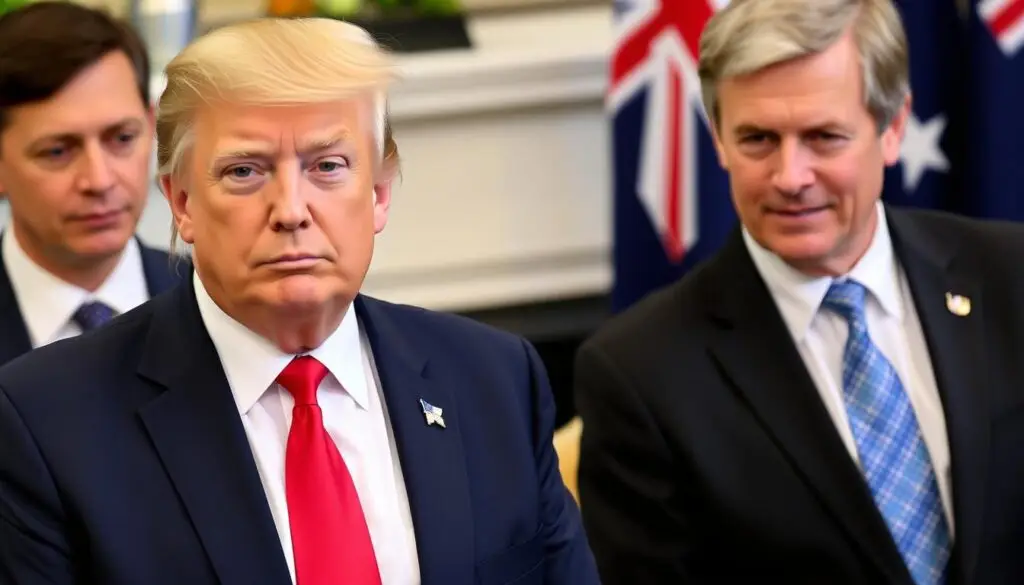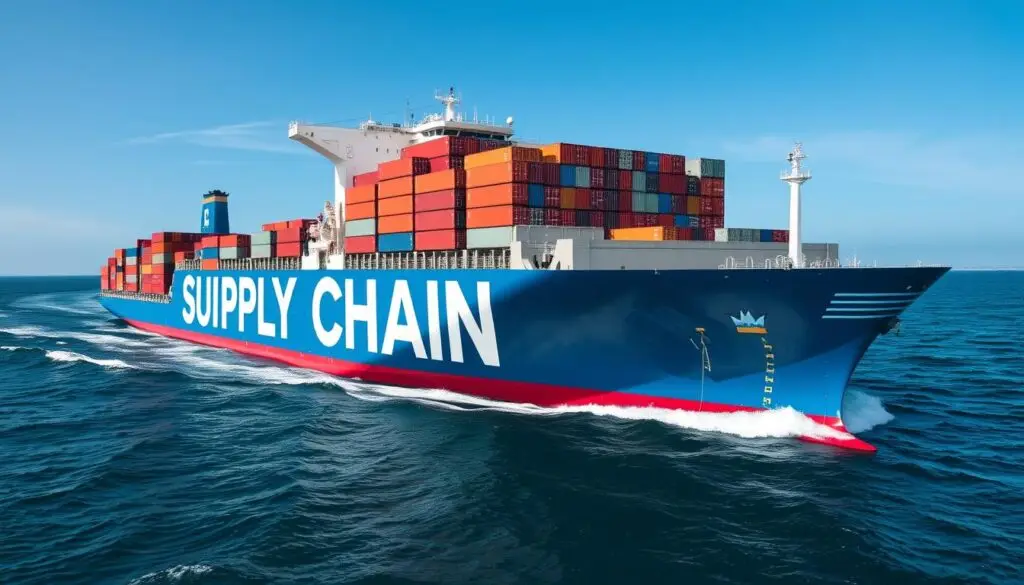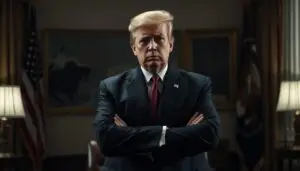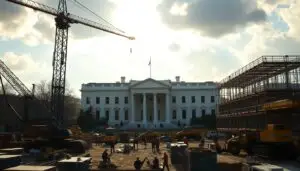Trump’s Mineral Deal with Australia Halts China’s US Supply.
Discover how Trump’s Mineral Deal with Australia disrupts China’s grip on the US rare earth minerals market and reshapes supply chains.

#image_title
On Monday at the White House, President Donald Trump and Prime Minister Anthony Albanese made a big move. They signed a deal on critical minerals, making the US a quicker path to getting rare earth minerals. This comes after China put limits on exports, aiming to avoid supply chain problems.
This deal allows the US to access Australian mines and processing facilities more quickly. It includes new funding, a price guarantee, and quicker project timelines. Reuters covered the signing, and Fox Business gave a detailed report on the critical minerals deal. Trump said it’s to make the global system safer and stop China’s “rare earth extortion.”
This news comes ahead of Trump’s visits to Malaysia and Japan, as well as the APEC summit in Gyeongju. The US is showing it’s ready to act, but experts say China can’t be ignored in rare earth minerals. Washington has warned it might raise tariffs up to 100% if needed.
Key Takeaways
- The United States and Australia signed a critical minerals framework to boost access to rare earth minerals.
- The mineral deal aims to mitigate supply chain disruptions linked to China’s export restrictions.
- New financing, processing projects, and a price floor aim to speed near-term output.
- Reuters documented the White House signing, while Fox Business detailed the scope of the agreement.
- Trump ties the plan to de-risking and possible tariff leverage up to 100%.
- Analysts warn that China’s influence on the rare earth supply is significant.
Trump’s Mineral Deal with Australia Halts China’s US Supply
This deal is a game-changer for supply chains. It puts Australia at the heart, linking mines, refineries, and buyers in one plan. Trump’s deal with Australia helps counter China’s control over US rare earth minerals by establishing steady supply routes.
The $8.5 billion agreement ensures steady output and flow to the U.S. industry. Reuters images show the signing as a formal pledge to prioritize mining and processing for energy, tech, and defense needs.
What the critical minerals framework includes
The pact outlines the journey from ore to end use. It covers exploration, permits, mining, and building separation plants in Australia. It also sets standards for rare earth minerals to reach U.S. manufacturers with clear traceability.
Partners will share data, synchronize approvals, and align environmental rules. The goal is to create fast, bankable projects that meet long-term contracts for magnets, batteries, and avionics.
Focus on mining and processing of Australian rare earth minerals
The plan aims to open new pits, reprocess waste, and expand at existing sites. It supports midstream facilities that upgrade concentrates and finish oxides. This ensures the supply of rare earth minerals in allied territory.
Priority corridors link Australian ports to U.S. assembly lines. This means shorter lead times, more transparent pricing, and less exposure to shocks.
At least $1 billion in financing and expanded cooperation over the next year
Public lenders and private funds will deploy at least $1 billion to speed up early works. Grants and offtake agreements help projects move from pilot to scale.
Over the next year, agencies will coordinate tenders, insurance, and logistics. This stack is designed to unlock large orders for magnets, chips, and defense systems.
| Element | Role in Supply Chain | Action Under Framework | Expected U.S. Benefit |
|---|---|---|---|
| Exploration | Identifies new deposits in Australia | Co-funded surveys and drilling | More verified reserves of rare earth minerals |
| Mining | Extracts ore at scale | Accelerated approvals and workforce support | Stable feedstock for U.S. buyers |
| Processing | Separates and refines concentrates | New separation facilities and QA standards | Higher-quality oxides for magnets |
| Finance | De-risks projects | At least $1B in loans, guarantees, and offtakes | Faster build times and lower capital costs |
| Logistics | Moves materials to end users | Port upgrades and secure shipping lanes | Shorter lead times and reliable deliveries |
Strategic aim: countering China’s rare earth export restrictions
The framework aims to offset tighter rules on magnet exports from China. By expanding Australian mining and processing, partners reduce exposure to sudden policy shifts.
Supply diversification pairs with leverage, as Trump’s mineral deal with Australia halts China’s us supply in key segments. The structure serves as a hedge while broader industrial policies scale up across the region.
Geopolitical context, supply chain disruption, and diplomatic tour
The mineral deal comes at a time of high tension. The United States seeks stable supplies of key materials, but faces new challenges in its supply chain. Leaders in Washington view rare earths as crucial for both the economy and national security, linking them to broader diplomatic efforts.

China’s dominance: about 90% of global rare earth mining and processing capacity
China dominates the mining and processing of rare earths, controlling prices and standards. This affects autos, clean energy, and defense. New export controls make this even more significant, as explained in this analysis of rare earth restrictions.
Analysts’ view: U.S. is years from rare earth self‑sufficiency
Experts say the United States is far from being self-sufficient in rare earths. Despite government funding and private investment, refining and magnet making face significant challenges. This makes the risk of supply chain problems high if policies change.
Tariff threats and leverage: possible triple‑digit tariffs as counterthreat
Washington warns that tariffs could be used if China tightens its exports. Triple-digit duties are considered as a way to influence China’s actions. This is part of ongoing negotiations and trade talks.
Coordinated outreach: upcoming visits to Malaysia and Japan, plus APEC in South Korea
The diplomatic tour will visit Malaysia and Japan, then APEC in South Korea. This aims to diversify sources, create regional processing paths, and reduce dependence on China. It’s done without harming commercial ties that the industry relies on.
Conclusion
Trump’s mineral deal aims to make the U.S. and Australia more self-sufficient. It plans to invest at least $1 billion in rare earth minerals. This will help mine and process these minerals outside of China.
Early targets include Australian sites. These sites will supply U.S. factories with EV motors, wind turbines, and defense systems.
But, China’s control over rare earth minerals is a big challenge. The U.S. is far from being self-sufficient, according to Raymond James analysts. To overcome this, Washington is using a mix of industrial policy and diplomacy.
Washington is planning visits to Malaysia and Japan. It will also attend APEC meetings in South Korea. Keeping tariffs as an option is also part of the strategy.
Australia could become key for diverse inputs if everything goes well. The U.S.–Australia critical minerals framework highlights several projects. These include refiners and assets in heavy rare earths.
For more details, see this overview of the USD 8.5 billion.
The coming months will reveal whether Trump’s deal is a stepping stone or merely a temporary solution. Success depends on steady funding, clear rules, and teamwork between the U.S. and Australia. If they succeed, the flow of rare earth minerals could change. This could lead to a more secure industrial base, built for resilience rather than reliance.
FAQ
What is the critical minerals framework signed by President Donald Trump and Prime Minister Anthony Albanese?
It’s a deal between the U.S. and Australia to get more rare earth minerals. The agreement was signed at the White House. It aims to secure materials needed for electronics and defense.
How does this deal address China’s restrictions on rare earth exports?
The deal aims to reduce U.S. reliance on China for rare earth minerals. It’s a move to counter China’s control over these vital materials.
What does the agreement include regarding mining and processing in Australia?
The deal focuses on speeding up mining and processing projects in Australia. It’s to meet U.S. demand for these minerals.
How much financing is committed, and over what time frame?
At least
FAQ
What is the critical minerals framework signed by President Donald Trump and Prime Minister Anthony Albanese?
It’s a deal between the U.S. and Australia to get more rare earth minerals. The agreement was signed at the White House. It aims to secure materials needed for electronics and defense.
How does this deal address China’s restrictions on rare earth exports?
The deal aims to reduce U.S. reliance on China for rare earth minerals. It’s a move to counter China’s control over these vital materials.
What does the agreement include regarding mining and processing in Australia?
The deal focuses on speeding up mining and processing projects in Australia. It’s to meet U.S. demand for these minerals.
How much financing is committed, and over what time frame?
At least $1 billion in financing is committed for the next year. This funding aims to start new projects quickly.
Why is rare earth diversification urgent for the United States?
China controls most of the world’s rare earth minerals. This gives China significant influence over the materials required for many U.S. technologies.
How does this framework fit into the broader strategy to de‑risk supply chains?
The deal is part of a plan to reduce the U.S.’s reliance on a single supplier. It aims to protect U.S. industries from supply chain disruptions.
Will the deal immediately halt China’s U.S. supply of rare earth minerals?
No, it won’t stop China’s supply right away. However, it will help identify other sources and reduce the U.S.’s reliance on China over time.
What do analysts say about the timeline for U.S. rare earth self‑sufficiency?
Analysts say the U.S. is years away from being self-sufficient. Building mines and refineries takes time and money.
Are tariffs part of the leverage in this minerals strategy?
Yes, tariffs are a part of the strategy. Trump has threatened to impose high tariffs on Chinese imports. This is to pressure China to change its export policies.
How does the diplomatic tour align with the minerals deal?
Trump’s tour is timed to support the minerals deal. He will meet leaders in Malaysia, Japan, and South Korea. The goal is to build support for secure mineral supply chains.
Who else is involved in the economic outreach around this initiative?
Treasury Secretary Scott Bessent will meet Chinese officials soon. This is part of a broader effort to balance pressure with dialogue.
What industries stand to benefit most from the U.S.–Australia mineral deal?
Electronics, renewable energy, aerospace, and defense will benefit most. They need rare earth minerals for their products.
How will the framework reduce supply chain disruption for U.S. manufacturers?
The deal will create new sources and routes for minerals. This reduces the risk of sudden supply cuts or price increases.
Does the agreement change the U.S.–China relationship?
It adds pressure but leaves room for talks. Trump hopes for a broader deal with China, even if tariffs are used as leverage.
What is the near‑term impact on the United States’ rare earth supply?
The deal signals a shift to more diverse sources. As Australian projects commence, U.S. access and prices are expected to improve, but complete independence will take time.
How does this mineral deal relate to the phrase “Trump’s mineral deal with Australia halts China’s us supply”?
The deal is a strategic move to reduce China’s control over U.S. supply. It won’t stop China’s supply right away but will limit its power over time.
billion in financing is committed for the next year. This funding aims to start new projects quickly.
Why is rare earth diversification urgent for the United States?
China controls most of the world’s rare earth minerals. This gives China significant influence over the materials required for many U.S. technologies.
How does this framework fit into the broader strategy to de‑risk supply chains?
The deal is part of a plan to reduce the U.S.’s reliance on a single supplier. It aims to protect U.S. industries from supply chain disruptions.
Will the deal immediately halt China’s U.S. supply of rare earth minerals?
No, it won’t stop China’s supply right away. However, it will help identify other sources and reduce the U.S.’s reliance on China over time.
What do analysts say about the timeline for U.S. rare earth self‑sufficiency?
Analysts say the U.S. is years away from being self-sufficient. Building mines and refineries takes time and money.
Are tariffs part of the leverage in this minerals strategy?
Yes, tariffs are a part of the strategy. Trump has threatened to impose high tariffs on Chinese imports. This is to pressure China to change its export policies.
How does the diplomatic tour align with the minerals deal?
Trump’s tour is timed to support the minerals deal. He will meet leaders in Malaysia, Japan, and South Korea. The goal is to build support for secure mineral supply chains.
Who else is involved in the economic outreach around this initiative?
Treasury Secretary Scott Bessent will meet Chinese officials soon. This is part of a broader effort to balance pressure with dialogue.
What industries stand to benefit most from the U.S.–Australia mineral deal?
Electronics, renewable energy, aerospace, and defense will benefit most. They need rare earth minerals for their products.
How will the framework reduce supply chain disruption for U.S. manufacturers?
The deal will create new sources and routes for minerals. This reduces the risk of sudden supply cuts or price increases.
Does the agreement change the U.S.–China relationship?
It adds pressure but leaves room for talks. Trump hopes for a broader deal with China, even if tariffs are used as leverage.
What is the near‑term impact on the United States’ rare earth supply?
The deal signals a shift to more diverse sources. As Australian projects commence, U.S. access and prices are expected to improve, but complete independence will take time.
How does this mineral deal relate to the phrase “Trump’s mineral deal with Australia halts China’s us supply”?
The deal is a strategic move to reduce China’s control over U.S. supply. It won’t stop China’s supply right away but will limit its power over time.




